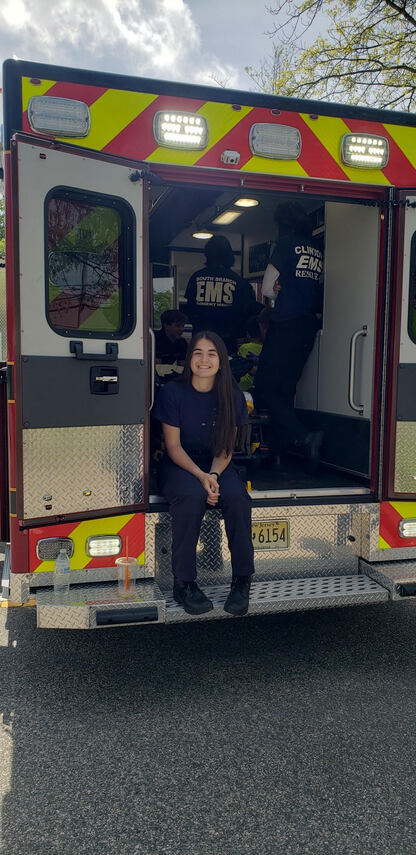Meet SBES Volunteer Cadet Nina Cirianni
A Meaningful Present Prepares Her for Her Future

As two South Branch Emergency Services EMTs treated the adult with a medical emergency, 17-year-old Cadet Nina Cirianni focused on the patient’s two young children.
“I talked to them about what they were doing earlier that day – they had gone to the dentist. We talked about the Tooth Fairy,” Nina said. “I was able to take their mind off the situation a bit. I think they would have been more scared if they didn’t have someone to talk to.”
Nina joined SBES in June 2021 when she was 15. Squad members made a presentation at North Hunterdon High School about the emergency medical, transport, and rescue services SBES provides, the important role volunteers play, and the free training available. Nina, a student in the Biomedical Sciences Academy who hopes to become an emergency room physician, couldn’t pass up the opportunity. “I thought it would be a good way to expose myself to emergency medicine,” she said.
Her SBES tenure began with training drills and meetings, where she learned skills that helped prepare her to assist EMTs on the ambulance. Assisting, observing, and asking questions of the EMTs she began riding with has helped her succeed in EMT class, which she will finish this month. “They have so much knowledge, I’ve learned a lot from the people I ride with,” she said. At this point in her EMT education, Nina can have a more direct role in patient care, including taking vital signs. “I hope to take the EMT exam as soon as possible and continue to volunteer as an EMT,” Nina said.
When she’s not volunteering or in class, Nina plays lacrosse and soccer. A rising high school senior who lives in Whitehouse Station, she plans to study health sciences and play lacrosse at Eastern Connecticut State University.
Nina’s continuing experience and training as an SBES volunteer has made her feel more confident and prepared for her future, she said. She also loves making a difference in her community right now. “Especially since I’ve started riding the ambulance, I’ve really seen how important a job it really is and how much of an impact you can make on people as the first ones to start patient care.”
“I talked to them about what they were doing earlier that day – they had gone to the dentist. We talked about the Tooth Fairy,” Nina said. “I was able to take their mind off the situation a bit. I think they would have been more scared if they didn’t have someone to talk to.”
Nina joined SBES in June 2021 when she was 15. Squad members made a presentation at North Hunterdon High School about the emergency medical, transport, and rescue services SBES provides, the important role volunteers play, and the free training available. Nina, a student in the Biomedical Sciences Academy who hopes to become an emergency room physician, couldn’t pass up the opportunity. “I thought it would be a good way to expose myself to emergency medicine,” she said.
Her SBES tenure began with training drills and meetings, where she learned skills that helped prepare her to assist EMTs on the ambulance. Assisting, observing, and asking questions of the EMTs she began riding with has helped her succeed in EMT class, which she will finish this month. “They have so much knowledge, I’ve learned a lot from the people I ride with,” she said. At this point in her EMT education, Nina can have a more direct role in patient care, including taking vital signs. “I hope to take the EMT exam as soon as possible and continue to volunteer as an EMT,” Nina said.
When she’s not volunteering or in class, Nina plays lacrosse and soccer. A rising high school senior who lives in Whitehouse Station, she plans to study health sciences and play lacrosse at Eastern Connecticut State University.
Nina’s continuing experience and training as an SBES volunteer has made her feel more confident and prepared for her future, she said. She also loves making a difference in her community right now. “Especially since I’ve started riding the ambulance, I’ve really seen how important a job it really is and how much of an impact you can make on people as the first ones to start patient care.”
South Branch Emergency Services is looking for volunteers like you!
No experience is necessary, and training and gear are provided for members.
Proudly Serving the Town of Clinton, Clinton Township, Lebanon Borough, High Bridge Borough, Hampton Borough, Glen Gardner Borough and portions of Franklin, Bethlehem and Union Townships since 1953
